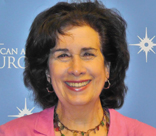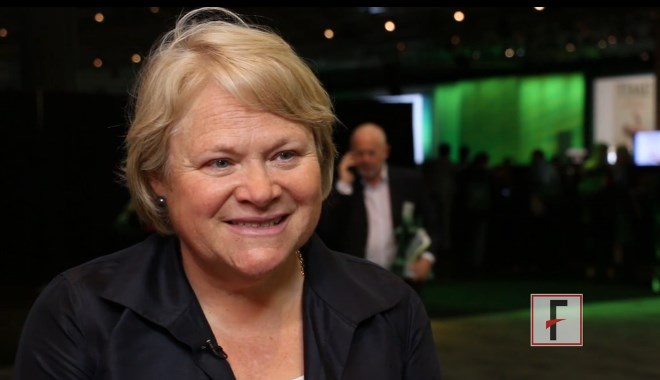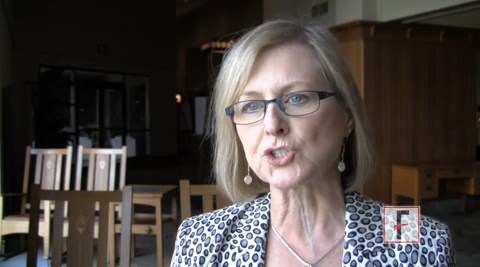User login
VIDEO: Less tricuspid regurgitation seen with Sano shunt in Norwood procedures
SEATTLE – Sano shunts outperform Blalock-Taussig shunts for Norwood procedures in neonates with hypoplastic left heart syndrome, according to a research registry study of 322 patients at the Cleveland Clinic and elsewhere.
The 166 newborns who had Sano shunts were matched to 166 who had Blalock-Taussig (BT) shunts.
“For comparable neonates with HLHS [hypoplastic left heart syndrome] undergoing Norwood operations, Sano offers better late survival [more than 3 years], less late tricuspid regurgitation, and perhaps less late right ventricular dysfunction than BT,” the investigators concluded.
Even so, Dr. Richard Ohye, professor of cardiac surgery at the University of Michigan, Ann Arbor, said the jury is still out on which shunt is best. He explained why in an interview at the American Association for Thoracic Surgery annual meeting. He also shared tips on shunt selection and explained a novel technique he has developed for doing a Sano shunt with a smaller hole in the right ventricle.
The video associated with this article is no longer available on this site. Please view all of our videos on the MDedge YouTube channel
SEATTLE – Sano shunts outperform Blalock-Taussig shunts for Norwood procedures in neonates with hypoplastic left heart syndrome, according to a research registry study of 322 patients at the Cleveland Clinic and elsewhere.
The 166 newborns who had Sano shunts were matched to 166 who had Blalock-Taussig (BT) shunts.
“For comparable neonates with HLHS [hypoplastic left heart syndrome] undergoing Norwood operations, Sano offers better late survival [more than 3 years], less late tricuspid regurgitation, and perhaps less late right ventricular dysfunction than BT,” the investigators concluded.
Even so, Dr. Richard Ohye, professor of cardiac surgery at the University of Michigan, Ann Arbor, said the jury is still out on which shunt is best. He explained why in an interview at the American Association for Thoracic Surgery annual meeting. He also shared tips on shunt selection and explained a novel technique he has developed for doing a Sano shunt with a smaller hole in the right ventricle.
The video associated with this article is no longer available on this site. Please view all of our videos on the MDedge YouTube channel
SEATTLE – Sano shunts outperform Blalock-Taussig shunts for Norwood procedures in neonates with hypoplastic left heart syndrome, according to a research registry study of 322 patients at the Cleveland Clinic and elsewhere.
The 166 newborns who had Sano shunts were matched to 166 who had Blalock-Taussig (BT) shunts.
“For comparable neonates with HLHS [hypoplastic left heart syndrome] undergoing Norwood operations, Sano offers better late survival [more than 3 years], less late tricuspid regurgitation, and perhaps less late right ventricular dysfunction than BT,” the investigators concluded.
Even so, Dr. Richard Ohye, professor of cardiac surgery at the University of Michigan, Ann Arbor, said the jury is still out on which shunt is best. He explained why in an interview at the American Association for Thoracic Surgery annual meeting. He also shared tips on shunt selection and explained a novel technique he has developed for doing a Sano shunt with a smaller hole in the right ventricle.
The video associated with this article is no longer available on this site. Please view all of our videos on the MDedge YouTube channel
AT THE AATS ANNUAL MEETING
VIDEO: Lasers take on the toughest scars
ASHEVILLE, N.C. – Advances in laser and light sources are making it possible to greatly improve the treatment of atrophic and hypertrophic scars, according to Dr. Michael Gold of the Gold Skin Care Center in Nashville, Tenn. In a video interview at the annual meeting of the Noah Worcester Dermatological Society, Dr. Gold explained how laser technology is being used today to manage contracture and other elements of the most challenging scars, such as those sustained by military personnel.
The video associated with this article is no longer available on this site. Please view all of our videos on the MDedge YouTube channel
ASHEVILLE, N.C. – Advances in laser and light sources are making it possible to greatly improve the treatment of atrophic and hypertrophic scars, according to Dr. Michael Gold of the Gold Skin Care Center in Nashville, Tenn. In a video interview at the annual meeting of the Noah Worcester Dermatological Society, Dr. Gold explained how laser technology is being used today to manage contracture and other elements of the most challenging scars, such as those sustained by military personnel.
The video associated with this article is no longer available on this site. Please view all of our videos on the MDedge YouTube channel
ASHEVILLE, N.C. – Advances in laser and light sources are making it possible to greatly improve the treatment of atrophic and hypertrophic scars, according to Dr. Michael Gold of the Gold Skin Care Center in Nashville, Tenn. In a video interview at the annual meeting of the Noah Worcester Dermatological Society, Dr. Gold explained how laser technology is being used today to manage contracture and other elements of the most challenging scars, such as those sustained by military personnel.
The video associated with this article is no longer available on this site. Please view all of our videos on the MDedge YouTube channel
AT NOAH 57
VIDEO: Nitrous oxide for IUD insertion improves patient satisfaction
SAN FRANCISCO – Intrauterine device insertion can be a painful experience, especially for nulliparous women, but the quest for an intervention to reduce pain has yielded disappointing results.
A new study, however, suggests that nitrous oxide improves women’s satisfaction with respect to pain management during the procedure.
In a video interview at the annual meeting of the American College of Obstetricians and Gynecologists, Dr. Lauren D. Thaxton of the University of New Mexico, Albuquerque, discusses the results of her randomized, controlled, double-blind trial comparing nitrous oxide and oxygen with oxygen alone in 80 women aged 13-45 years. Women receiving nitrous oxide didn’t have lower visual analog scale pain scores than those receiving oxygen, but did report significantly greater satisfaction with pain management, she said.
Dr. Thaxton reported having no financial disclosures.
The video associated with this article is no longer available on this site. Please view all of our videos on the MDedge YouTube channel
SAN FRANCISCO – Intrauterine device insertion can be a painful experience, especially for nulliparous women, but the quest for an intervention to reduce pain has yielded disappointing results.
A new study, however, suggests that nitrous oxide improves women’s satisfaction with respect to pain management during the procedure.
In a video interview at the annual meeting of the American College of Obstetricians and Gynecologists, Dr. Lauren D. Thaxton of the University of New Mexico, Albuquerque, discusses the results of her randomized, controlled, double-blind trial comparing nitrous oxide and oxygen with oxygen alone in 80 women aged 13-45 years. Women receiving nitrous oxide didn’t have lower visual analog scale pain scores than those receiving oxygen, but did report significantly greater satisfaction with pain management, she said.
Dr. Thaxton reported having no financial disclosures.
The video associated with this article is no longer available on this site. Please view all of our videos on the MDedge YouTube channel
SAN FRANCISCO – Intrauterine device insertion can be a painful experience, especially for nulliparous women, but the quest for an intervention to reduce pain has yielded disappointing results.
A new study, however, suggests that nitrous oxide improves women’s satisfaction with respect to pain management during the procedure.
In a video interview at the annual meeting of the American College of Obstetricians and Gynecologists, Dr. Lauren D. Thaxton of the University of New Mexico, Albuquerque, discusses the results of her randomized, controlled, double-blind trial comparing nitrous oxide and oxygen with oxygen alone in 80 women aged 13-45 years. Women receiving nitrous oxide didn’t have lower visual analog scale pain scores than those receiving oxygen, but did report significantly greater satisfaction with pain management, she said.
Dr. Thaxton reported having no financial disclosures.
The video associated with this article is no longer available on this site. Please view all of our videos on the MDedge YouTube channel
AT THE ACOG ANNUAL CLINICAL MEETING
VIDEO: Age, race influence understanding of the term ‘Pap smear’
SAN FRANCISCO – Deaths from cervical cancer have declined, but disparities – particularly among the uninsured – remain a concern, as nearly 29% of uninsured white women and more than 17% of uninsured Hispanic women have not been screened in the past 5 years, according to Dr. David Leighton Howard.
To assess understanding of the term “Pap smear” as a possible contributor to low screening rates, Dr. Howard and his colleagues surveyed both English-speaking and Spanish-speaking women and found that about two-thirds of the 160 English-speaking and 123 Spanish-speaking respondents were unable to distinguish between a pelvic exam and a Pap smear, but that a comparable percentage in both groups (74% and 70%, respectively), were able to identify at least one correct descriptor of the term. Those able to identify correct descriptors were more likely to be older (37 years vs. 29 years for English-speaking women and 36 years vs. 30 years for Spanish-speaking women), Dr. Howard of Joint Base Langley-Eustis, U.S. Air Force, Hampton, Va., reported at the annual meeting of the American College of Obstetricians and Gynecologists.
Paradoxically, Dr. Howard said, Spanish-speaking women were significantly less likely than were English-speaking women to use incorrect descriptors for the term Pap smear. Fewer said a Pap smear is the same as a pelvic examination (43% vs. 74%), is a test for a sexually transmitted disease (24% vs. 56%), is a pregnancy test (17% vs. 36%), or is a checkup (20% vs. 53%).
In a video interview, Dr. Howard discussed his findings, as well as the need for more research into the factors behind the age and ethnicity associations in his study.
The video associated with this article is no longer available on this site. Please view all of our videos on the MDedge YouTube channel
SAN FRANCISCO – Deaths from cervical cancer have declined, but disparities – particularly among the uninsured – remain a concern, as nearly 29% of uninsured white women and more than 17% of uninsured Hispanic women have not been screened in the past 5 years, according to Dr. David Leighton Howard.
To assess understanding of the term “Pap smear” as a possible contributor to low screening rates, Dr. Howard and his colleagues surveyed both English-speaking and Spanish-speaking women and found that about two-thirds of the 160 English-speaking and 123 Spanish-speaking respondents were unable to distinguish between a pelvic exam and a Pap smear, but that a comparable percentage in both groups (74% and 70%, respectively), were able to identify at least one correct descriptor of the term. Those able to identify correct descriptors were more likely to be older (37 years vs. 29 years for English-speaking women and 36 years vs. 30 years for Spanish-speaking women), Dr. Howard of Joint Base Langley-Eustis, U.S. Air Force, Hampton, Va., reported at the annual meeting of the American College of Obstetricians and Gynecologists.
Paradoxically, Dr. Howard said, Spanish-speaking women were significantly less likely than were English-speaking women to use incorrect descriptors for the term Pap smear. Fewer said a Pap smear is the same as a pelvic examination (43% vs. 74%), is a test for a sexually transmitted disease (24% vs. 56%), is a pregnancy test (17% vs. 36%), or is a checkup (20% vs. 53%).
In a video interview, Dr. Howard discussed his findings, as well as the need for more research into the factors behind the age and ethnicity associations in his study.
The video associated with this article is no longer available on this site. Please view all of our videos on the MDedge YouTube channel
SAN FRANCISCO – Deaths from cervical cancer have declined, but disparities – particularly among the uninsured – remain a concern, as nearly 29% of uninsured white women and more than 17% of uninsured Hispanic women have not been screened in the past 5 years, according to Dr. David Leighton Howard.
To assess understanding of the term “Pap smear” as a possible contributor to low screening rates, Dr. Howard and his colleagues surveyed both English-speaking and Spanish-speaking women and found that about two-thirds of the 160 English-speaking and 123 Spanish-speaking respondents were unable to distinguish between a pelvic exam and a Pap smear, but that a comparable percentage in both groups (74% and 70%, respectively), were able to identify at least one correct descriptor of the term. Those able to identify correct descriptors were more likely to be older (37 years vs. 29 years for English-speaking women and 36 years vs. 30 years for Spanish-speaking women), Dr. Howard of Joint Base Langley-Eustis, U.S. Air Force, Hampton, Va., reported at the annual meeting of the American College of Obstetricians and Gynecologists.
Paradoxically, Dr. Howard said, Spanish-speaking women were significantly less likely than were English-speaking women to use incorrect descriptors for the term Pap smear. Fewer said a Pap smear is the same as a pelvic examination (43% vs. 74%), is a test for a sexually transmitted disease (24% vs. 56%), is a pregnancy test (17% vs. 36%), or is a checkup (20% vs. 53%).
In a video interview, Dr. Howard discussed his findings, as well as the need for more research into the factors behind the age and ethnicity associations in his study.
The video associated with this article is no longer available on this site. Please view all of our videos on the MDedge YouTube channel
AT THE ACOG ANNUAL CLINICAL MEETING
Elinor Ben-Menachem, MD
The video associated with this article is no longer available on this site. Please view all of our videos on the MDedge YouTube channel
The video associated with this article is no longer available on this site. Please view all of our videos on the MDedge YouTube channel
The video associated with this article is no longer available on this site. Please view all of our videos on the MDedge YouTube channel
Robert Fox, MD
The video associated with this article is no longer available on this site. Please view all of our videos on the MDedge YouTube channel
The video associated with this article is no longer available on this site. Please view all of our videos on the MDedge YouTube channel
The video associated with this article is no longer available on this site. Please view all of our videos on the MDedge YouTube channel
Alice Cronin-Golomb, PhD
The video associated with this article is no longer available on this site. Please view all of our videos on the MDedge YouTube channel
The video associated with this article is no longer available on this site. Please view all of our videos on the MDedge YouTube channel
The video associated with this article is no longer available on this site. Please view all of our videos on the MDedge YouTube channel
VIDEO: Cervicovaginal microbiome holds promise in preventing preterm birth
SAN FRANCISCO– Predicting and preventing preterm birth continues to be a challenge for clinicians, but new research into the cervicovaginal microbiome could help explain the premature cervical remodeling that precedes preterm birth and ultimately lead to the development of novel therapeutics.
Researchers at the University of Pennsylvania recently found that there is a distinct molecular profile in the cervix that is associated with preterm birth and can be assessed noninvasively using RNA Pap testing.
In a video interview at the annual meeting of the American Congress of Obstetricians and Gynecologists, Dr. Michal Elovitz, director of the maternal and child health research program and the prematurity prevention program at the University of Pennsylvania, Philadelphia, said that the findings represent a “fork in the road” that could change how clinicians treat preterm birth, provided the findings can be validated in other studies.
The video associated with this article is no longer available on this site. Please view all of our videos on the MDedge YouTube channel
mschneider@frontlinemedcom.com
On Twitter @maryellenny
SAN FRANCISCO– Predicting and preventing preterm birth continues to be a challenge for clinicians, but new research into the cervicovaginal microbiome could help explain the premature cervical remodeling that precedes preterm birth and ultimately lead to the development of novel therapeutics.
Researchers at the University of Pennsylvania recently found that there is a distinct molecular profile in the cervix that is associated with preterm birth and can be assessed noninvasively using RNA Pap testing.
In a video interview at the annual meeting of the American Congress of Obstetricians and Gynecologists, Dr. Michal Elovitz, director of the maternal and child health research program and the prematurity prevention program at the University of Pennsylvania, Philadelphia, said that the findings represent a “fork in the road” that could change how clinicians treat preterm birth, provided the findings can be validated in other studies.
The video associated with this article is no longer available on this site. Please view all of our videos on the MDedge YouTube channel
mschneider@frontlinemedcom.com
On Twitter @maryellenny
SAN FRANCISCO– Predicting and preventing preterm birth continues to be a challenge for clinicians, but new research into the cervicovaginal microbiome could help explain the premature cervical remodeling that precedes preterm birth and ultimately lead to the development of novel therapeutics.
Researchers at the University of Pennsylvania recently found that there is a distinct molecular profile in the cervix that is associated with preterm birth and can be assessed noninvasively using RNA Pap testing.
In a video interview at the annual meeting of the American Congress of Obstetricians and Gynecologists, Dr. Michal Elovitz, director of the maternal and child health research program and the prematurity prevention program at the University of Pennsylvania, Philadelphia, said that the findings represent a “fork in the road” that could change how clinicians treat preterm birth, provided the findings can be validated in other studies.
The video associated with this article is no longer available on this site. Please view all of our videos on the MDedge YouTube channel
mschneider@frontlinemedcom.com
On Twitter @maryellenny
AT THE ACOG ANNUAL CLINICAL MEETING
VIDEO: Are birthing centers a safe choice for women?
SAN FRANCISCO – The number of babies delivered at birthing centers in the United States is still very low, but freestanding birthing facilities are growing rapidly. Are these centers, many of which are not accredited, safe choices for women who are looking for a noninstitutional birth experience?
At the annual meeting of the American Congress of Obstetricians and Gynecologists, Dr. Edward R. Yeomans, chair of the department of ob.gyn. at Texas Tech University, Lubbock, faced off against Ginger Breedlove, Ph.D., president of the American College of Nurse-Midwives, in a debate about the preferred site for delivery.
Dr. Yeomans, who favors hospital-based deliveries, said that safety is the major issue. Birthing centers are not equipped to deal with emergencies that can arise even in low-risk pregnancies and may require immediate access to surgery or a blood bank.
Dr. Breedlove countered that accredited birthing centers have strict standards for the cases they accept and have transport plans in place for emergencies. She added that she supports accreditation for all freestanding birthing centers.
mschneider@frontlinemedcom.com
On Twitter @maryellenny
SAN FRANCISCO – The number of babies delivered at birthing centers in the United States is still very low, but freestanding birthing facilities are growing rapidly. Are these centers, many of which are not accredited, safe choices for women who are looking for a noninstitutional birth experience?
At the annual meeting of the American Congress of Obstetricians and Gynecologists, Dr. Edward R. Yeomans, chair of the department of ob.gyn. at Texas Tech University, Lubbock, faced off against Ginger Breedlove, Ph.D., president of the American College of Nurse-Midwives, in a debate about the preferred site for delivery.
Dr. Yeomans, who favors hospital-based deliveries, said that safety is the major issue. Birthing centers are not equipped to deal with emergencies that can arise even in low-risk pregnancies and may require immediate access to surgery or a blood bank.
Dr. Breedlove countered that accredited birthing centers have strict standards for the cases they accept and have transport plans in place for emergencies. She added that she supports accreditation for all freestanding birthing centers.
mschneider@frontlinemedcom.com
On Twitter @maryellenny
SAN FRANCISCO – The number of babies delivered at birthing centers in the United States is still very low, but freestanding birthing facilities are growing rapidly. Are these centers, many of which are not accredited, safe choices for women who are looking for a noninstitutional birth experience?
At the annual meeting of the American Congress of Obstetricians and Gynecologists, Dr. Edward R. Yeomans, chair of the department of ob.gyn. at Texas Tech University, Lubbock, faced off against Ginger Breedlove, Ph.D., president of the American College of Nurse-Midwives, in a debate about the preferred site for delivery.
Dr. Yeomans, who favors hospital-based deliveries, said that safety is the major issue. Birthing centers are not equipped to deal with emergencies that can arise even in low-risk pregnancies and may require immediate access to surgery or a blood bank.
Dr. Breedlove countered that accredited birthing centers have strict standards for the cases they accept and have transport plans in place for emergencies. She added that she supports accreditation for all freestanding birthing centers.
mschneider@frontlinemedcom.com
On Twitter @maryellenny
AT THE ACOG ANNUAL CLINICAL MEETING
VIDEO: Collaboration with primary care helps colleagues and patients
ASHEVILLE, N.C. – Building bridges with colleagues in other specialties, especially primary care, helps patients and improves relations among specialties, Dr. Lisa Garner said in an interview at the annual meeting of the Noah Worcester Dermatological Society.
“Communicating is key for patient care,” she said. Dr. Garner, a dermatologist in private practice in Garland, Tex., chaired the American Academy of Dermatology’s Perceptions of Dermatology task force, which assessed perceptions of dermatologists and dermatology within the house of medicine from 2012 to 2014.
Dr. Garner had no financial conflicts to disclose.
The video associated with this article is no longer available on this site. Please view all of our videos on the MDedge YouTube channel
ASHEVILLE, N.C. – Building bridges with colleagues in other specialties, especially primary care, helps patients and improves relations among specialties, Dr. Lisa Garner said in an interview at the annual meeting of the Noah Worcester Dermatological Society.
“Communicating is key for patient care,” she said. Dr. Garner, a dermatologist in private practice in Garland, Tex., chaired the American Academy of Dermatology’s Perceptions of Dermatology task force, which assessed perceptions of dermatologists and dermatology within the house of medicine from 2012 to 2014.
Dr. Garner had no financial conflicts to disclose.
The video associated with this article is no longer available on this site. Please view all of our videos on the MDedge YouTube channel
ASHEVILLE, N.C. – Building bridges with colleagues in other specialties, especially primary care, helps patients and improves relations among specialties, Dr. Lisa Garner said in an interview at the annual meeting of the Noah Worcester Dermatological Society.
“Communicating is key for patient care,” she said. Dr. Garner, a dermatologist in private practice in Garland, Tex., chaired the American Academy of Dermatology’s Perceptions of Dermatology task force, which assessed perceptions of dermatologists and dermatology within the house of medicine from 2012 to 2014.
Dr. Garner had no financial conflicts to disclose.
The video associated with this article is no longer available on this site. Please view all of our videos on the MDedge YouTube channel
EXPERT ANALYSIS FROM NOAH 57









